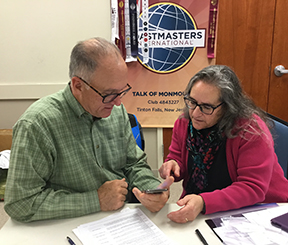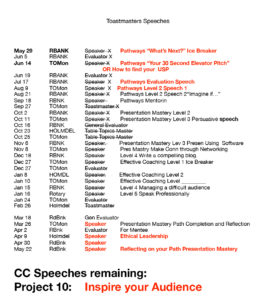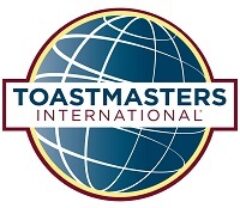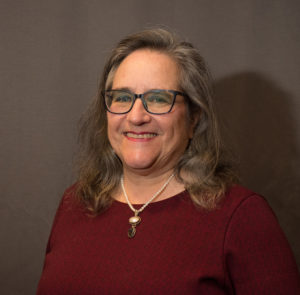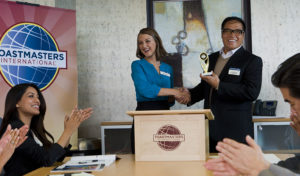The infancy of Pathways has evoked an array of emotions from my fellow Toastmasters. Throughout the district, I have seen everything from enthusiasm, resulting in some of my fellow members becoming Pathways Guides before the launch to outright declarations of protest. As a Vice President of Membership, I have seen Toastmasters not renew their membership because of their claim that Pathways “has nothing to offer me.”
With a change as big as Pathways being rolled out to an organization of over 94 years, it is easy to see its flaws and even participate in regular debates around the subject as we learn more with each passing month. As we move forward with these changes, I want to challenge my fellow Toastmasters to be mindful of how we discuss both the growing pains and excitement— particularly, in front of newer Toastmasters who may have never been acquainted with the traditional educational program. From time to time, I have noticed newer members who attend a district workshop or conference with excitement over all of the new skills they will learn become deflated when they overhear occasional grumbles and complaints about the only program they have to pursue, Pathways.
It is our job as tenured Toastmasters to encourage our newer members, especially the more apprehensive ones, to lean in and attack their goals at meetings. The best way to do that is through leading by example, even when it means stepping out of our comfort zone. It all comes back to the Toastmasters core values when we look at the big picture. We should embrace Pathways for our newer members or, “Toastmasters of the next generation” as I like to call them, in order to:
- Uphold the Integrity of Toastmasters. Our mission and member’s goal are still the same; there may just be more than one way to get there now.
- Continue a culture of Respect for our fellow Toastmasters who are working hard to provide the resources we need to make Pathways a success in our district.
- Be of Service to others. More knowledge leads to more opportunities to mentor, teach, and share what you know.
- Claim our own Excellence. Starting a new learning path does not erase your hard work or skills you have claimed so far in your Toastmasters journey.
Maintain the Integrity of Our Mission to Become Better Leaders and Communicators
A newer member of my home club approached me one evening asking some questions about Pathways. Instead of stumbling through them, half-uncertain, I invited her to come with me to a Pathways workshop being held that Saturday.
Not only did this learning session help this new member get started with her first speech (she will give her second in the next few weeks!), but it also helped the Toastmasters hosting the session with their leadership development. It helped me become more familiar with the resources available to us through Pathways. It gave me more information I needed to lead with confidence, even if it is just in a low-key mentorship relationship for right now.
Toastmasters maintains its integrity by delivering what it promised to from the start, so I challenge you to consider what your goals are in being part of Toastmasters. Does it have to do with communication? Leadership? If so, you’re still in the right place. There is just more than one way to get there now.
Respect the Process of Change and Those Who Work Hard to Smooth the Transition
Everyone is entitled to their opinion on all of the changes going on around us. While we have these discussions and share those opinions, it is important to remember that we have new members to consider those who aren’t tainted by the memories of “how things used to be.” It is easy to play the critic when we have something to compare it to.
Our District 83 Pathways Guides, officers, and directors working hard to educate us on these changes and answer the endless stream of questions. While the changes may be difficult for us, it is important to show respect for those looking to smooth the way, especially with a transition period as long as two years between the rollout and the retirement of the traditional program. Would you complain loudly and proudly if your boss was leading you through a change at work with grace and strong leadership? Probably not. The best thing we can do is be grateful for the wealth of resources we have available to us and use them to our advantage.
Embrace Change Because it’s Showing Service to Others
The topic of change reminds me of my first job out of a graduate school. As a licensing specialist at a large software/hardware reseller, it was my job to learn about seemingly arbitrary licensing rules and relay that information to sales reps. Just as I was getting the hang of these licensing rules and felt confident in my skills, our software partner decided to change the entire licensing structure. We would have a grace period of about two years to smooth the transition for customers, which required a lot of extra knowledge around both licensing structures and how they would work together. Sounds familiar?
Around the same time, I was asked to train a new team member. In a situation that would normally leave me feeling in over my head, I found myself feeling grateful for the opportunity. Learning alongside my trainee and finding answers to questions that had not come yet were all rich learning opportunities for me. Furthermore, I mindfully kept any complaints about all of the changes away from his training to set a professional and positive tone for the work we had to get done.
Pathways aren’t very different! To embrace Pathways does not mean you have to quit the traditional path right away. You can work in both the traditional and Pathways curriculum at the same time during the grace period. It’s all about baby steps. Consider hosting an Icebreaker night for your club, dedicated to speakers knocking out the first speech in their path. A gesture like this could be just what your club needs to get some speakers started in their Toastmasters journey. By setting aside this time for your club, you could be providing a great service to speakers who haven’t been able to get a speaking slot since joining Toastmasters.
Excellence
Finally, being a Toastmaster means we exude excellence in everything we do. Doing an Icebreaker and starting a new learning curriculum, even after earning multiple advanced awards, will not undo the skills you have gained so far. If anything, going back to the basics is a chance to see how far you have come in your skills.
My very first Icebreaker two and a half years ago was a pretty standard one that consisted of me naming off a laundry list of things about myself for several minutes. My Icebreaker just a few months ago for Pathways consisted of me skipping around the room, wrapping a feather boa around a fellow Toastmaster, and handing out party noisemakers, delivering a speech about my independent spirit and how that fit into preparing for my upcoming marriage. The feedback I received and creative risks I took all made the Icebreaker a worthwhile (and fun!) project. We all have something to learn from any speech we deliver. Our excellence will remain the same as we do it.
I encourage you to revisit the core values of Toastmasters and consider what they mean to you as you examine your goals for 2019. Write them out. Ask your fellow Toastmasters how you can help them reach their goals. Pathways is an opportunity for all of us to embrace integrity, respect, service, and excellence in our speaking journey. Join me in leading the way for Toastmasters of the next generation.
